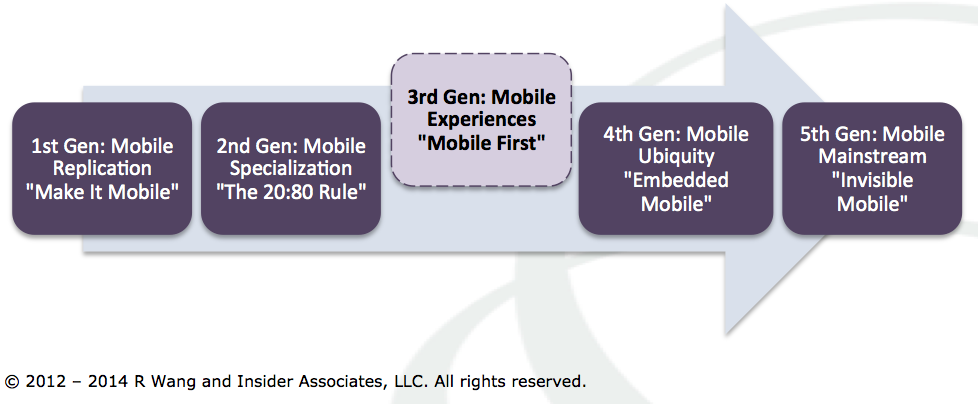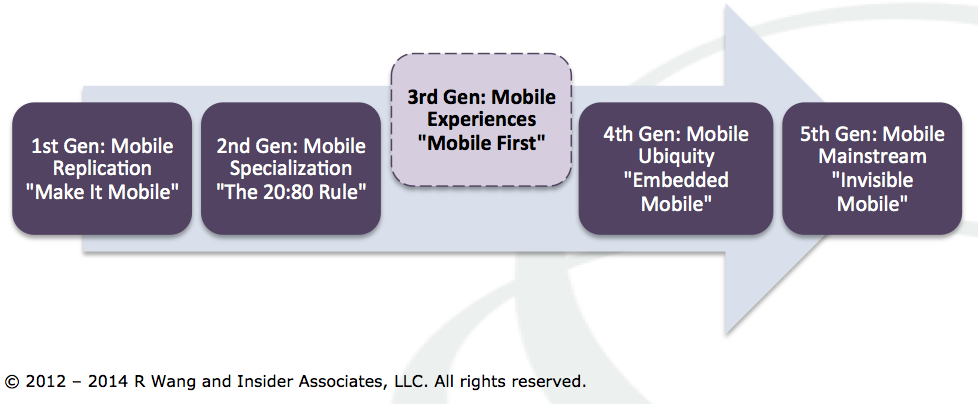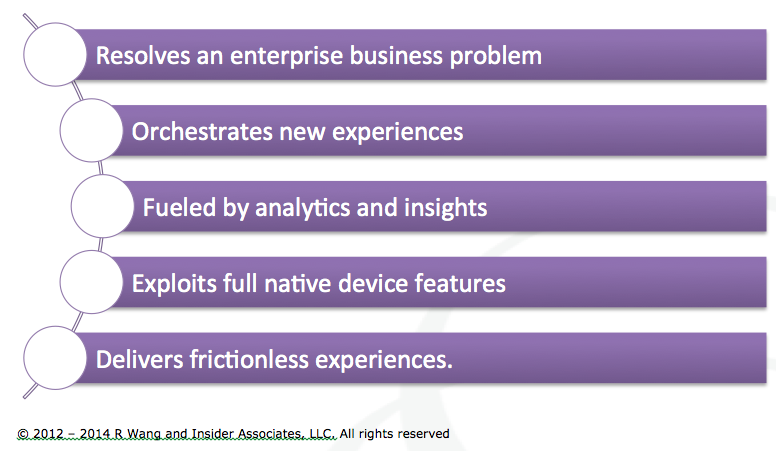
Monday's Musings: Why The Third Generation Of Enterprise Mobile Is Designed For Digital Transformation
Mobile Is The Main Entry Point For Digital Transformation
Mobile initiatives provide an entry point into digital. Mobile first is more than a mantra. Why? By applying design thinking to solving specific and purposeful tasks and processes, organizations can rethink the digital journey with mobile projects. More importantly, mobile enables organizations to break the silos of existing systems from mainframes to on-premises systems and bring new life to legacy applications usage. Many market leaders and fast followers have mobilized their mainframe, legacy apps, and enabled users to access data and information with minimal additional cost with a transformed user experience. Others have used mobile as an opportunity to break down functional fiefdoms and process silos in their digital transformation efforts.
First and Second Generation Of Enterprise Mobile Apps Rarely Lived Up To The Full Potential Of Mobility
Consumerization of technology in the enterprise, richer user experiences, improved mobile networks, and the rapid adoption of cost effective mobile solutions among the workforce drove demand for the first wave of enterprise mobile apps (see Figure 1). While these apps served as a launch pad for future advancements, the first and second-generation apps failed to meet expectations because they:
Figure 1. The Third Generation Of Enterprise Mobile Apps Has Arrived
- Rarely took advantage of advanced native features. Instead of crafting new experiences, first and second-generation apps, mostly mimicked the same experiences as the systems of transaction they replaced. Hence, old verbs such as create, read, update, delete, and search dominated the experiences. New verbs include comment, like, share, publish, and collaborate. In addition, cameras, audio, and bluetooth interfaces add to the sense and response nature of third generation mobile apps.
- Narrowly focused on replicating existing capabilities. Many of the first-generation mobile apps attempted to replicate legacy functionality on the mobile footprint. Complicated business processes, large data sets, and slow bandwidth met small screen sizes, lack of disconnected solutions, and cloogey user experiences. The result - existing apps were partially mobilized. However, organizations faced limited adoption. Second-generation mobile apps addressed the issue by applying the 20:80 rule and focused on the 20 percent of apps that were used 80 percent of the time. While user experience improved with responsive designs, screen sizes grew, and connectivity improved, users remained frustrated with the widening gap between the art of the possible in consumer mobile and the reality of deployment inside their enterprise.
- Largely remained departmental or siloed in functionality. Most first and second-generation apps often remained in forced fit functional silos representative of the functional fiefdoms inside organizations. Few mobile apps brought data and information from other disciplines. Mashups such as taking HR capabilities and tying them to marketing remained rare in not only design, but also actual delivery. Even fewer mobile apps could bring cross-functional analytics and insight to the user.
Preorder Disrupting Digital Business, published by Harvard Business Review Press In Q2 2015. Learn more.
The Third Generation Of Mobile First Apps Address The Needs Of Digital Businesses
The shift from systems of transaction and systems of engagement to systems of experience requires mobile apps to create new experiences. This shift from analog to digital design points is the underlying trend in digital transformation as systems progress from massive social scale to massive contextual scale (see Figure 2). User experiences shift from interactive to bionic as impact and reach move from interconnected to segmented value chains. Further, loosely structured
knowledge and deterministic business rules evolve into immersive intelligence streams guided by probabilistic pattern based intelligence.
Figure 2. The Shift From Analog To Digital Begins With A Design Point For Intention Driven

In fact the intersection of mobile and analytics is a key gateway to digital transformation projects. The third generation of enterprise mobile apps shares five key characteristics (see Figure 3).
Figure 3. Five Key Characteristics Of Third Gen Mobile Apps
- Resolves an enterprise business problem. Third generation enterprise mobile apps apply design thinking to identify, design, and deliver innovative solutions to business problems. These apps solve cross-functional challenges to the organization.
- Orchestrates new experiences. Smartphones and other related devices serve as the primary interface design point into enterprise systems. The goal is not to replicate what’s been created but to craft new experiences.
- Fuels a data to decision backbone with analytics and insights. The goal of these third generation apps is to democratize data and decision-making. Situational contextual awareness is built on top of big data and analytics. Imagine the collective knowledge and power of an entire enterprise at an employee’s fingertips
- Exploits full native device features. Next generation apps incorporate the plethora of physical sensors such as accelerometers, gyroscopes, magnetometers, barometer, humidity, pressure, light, proximity, and heart rate into the solution design. For example, key enterprise mobility enablers often include the microphone, GPS, iBeacon, GPS.
- Delivers frictionless experiences. Customers expect seamless orchestration and integration of information from both internal and external sources. Mobile experiences must drive friction out of establishing identity. Signature capture, contextual relevance, and continuity of access across devices are key enablers expected in third generation enterprise mobile apps.
The Bottom Line: Use Mobile As The Gateway For Your Enterprise Digital Transformation Projects
Constellation believes that mobile is more than just the device. While smart phones and other devices provide a key enabler, design in digital transformation should take into account how these technologies address the business value and business model transformation required to deliver on break through innovation. These devices provide the sense and respond, the interactivity, and the connectivity required for digital transformation. In applying mobile solutions to the solution design point, Constellation recommends that clients:
- Assess how third generation enterprise mobile apps can change the business. Constellation recommends that clients seek the most common, cross-functional business problem that cannot be solved with linear thinking. Articulate the business problem and benefit. Show how the solution orchestrates new experiences. Identify how analytics and insights can fuel the business model shift. Exploit full native device features. Seek frictionless experiences.
- Determine whether to build, buy, or modify. Given the scarcity of third generation enterprise mobile solutions, most organizations fear the need to staff up large mobile app dev shops. Where solutions have been developed, expect to take these solutions as a platform to expand from. Where solutions have not been developed, Constellation suggests that organizations who have strong app dev shops, standardize on a mobile app platform for development. For those who lack the resources or would prefer not to staff up for mobile app dev, Constellation suggests engagement with design shops and system integrators who have platforms that can scale for the rapid of pace of change in mobile development.
- Plan for a mobile experience workshop. As part of the design thinking process, clients move beyond the inquiry or exploratory conversation to solidify objectives. The process starts with a proof of concept, road mapping engagement, and then the actual enterprise mobility project. The process often results in quick wins for the business side and cuts cost out of the IT budget.
Your POV.
Ready for digital disruption by starting with mobile? Add your comments to the blog or reach me via email: R (at) ConstellationR (dot) com or R (at) SoftwareInsider (dot) org.
- Developing your digital business strategy
- Connecting with other pioneers
- Sharing best practices
- Vendor selection
- Implementation partner selection
- Providing contract negotiations and software licensing support
- Demystifying software licensing
Resources
- Quips: Digital Transformation – Defining The Fundamental Elements For Digital CXOs
- Personal Log: Coming soon! Disrupting Digital Business – The Book
- News Analysis: Adobe EchoSign’s Electronic Signatures Goes 100% Mobile
- Monday’s Musings: Who Gets To Be A Chief Digital Officer?
- Monday’s Musings: The Seven Rules For Digital Business And Digital Transformation
- Tuesday’s Tip: Five Steps To Starting Your Digital Transformation Initiative
- Monday’s Musings: What Organizations Want From Mobile
- Research Summary: Economic Trends Exacerbate Digital Business Disruption And Digital Transformation (The Futurist Framework Part 3)
- Research Summary: Five Societal Shifts Showcase The Digital Divide Ahead (The Futurist Framework Part 2)
- Research Summary: Sneak Peaks From Constellation’s Futurist Framework And 2014 Outlook On Digital Disruption
- Research Report: Digital ARTISANs – The Seven Building Blocks Behind Building A Digital Business DNA
- Research Summary: Five Societal Shifts Showcase The Digital Divide Ahead (The Futurist Framework Part 2)
- Research Summary: Next Generation CIOs Aspire To Focus More On Innovation And The Chief Digital Officer Role
- Trends: [VIDEO] The Digital Business Disruption Ahead Preview – NASSCOM India Leadership Forum (#NASSCOM_ILF)
- News Analysis: New #IBMWatson Business Group Heralds The Commercialization Of Cognitive Computing. Ready For Augmented Humanity?
- Harvard Business Review: What a Big Data Business Model Looks Like
- Monday’s Musings: How The Five Consumer Tech Macro Pillars Influence Enterprise Software Innovation
- Tuesday’s Tip: Understand The Five Generation Of Digital Workers And Customers
- Monday’s Musings: The Chief Digital Officer In The Age Of Digital Business
- Slide Share: The CMO vs CIO – Pathways To Collaboration
- Event Report: CRM Evolution 2013 – Seven Trends In The Return To Digital Business And Customer Centricity
- News Analysis: Sitecore Acquires Commerce Server In Quest Towards Customer Experience Management
- News Analysis: Salesforce 1 Signals Support For Digital Business at #DF13
- Research Summary And Speaker Notes: The Identity Manifesto – Why Identity Is At The Heart of Digital Business
Reprints
Reprints can be purchased through Constellation Research, Inc. To request official reprints in PDF format, please contact Sales .
Disclosure
Although we work closely with many mega software vendors, we want you to trust us. For the full disclosure policy,stay tuned for the full client list on the Constellation Research website.
* Not responsible for any factual errors or omissions. However, happy to correct any errors upon email receipt.
Copyright © 2001 -2014 R Wang and Insider Associates, LLC All rights reserved.
Contact the Sales team to purchase this report on a a la carte basis or join the Constellation Customer Experience
 R "Ray" Wang
R "Ray" Wang R "Ray" Wang
R "Ray" Wang

